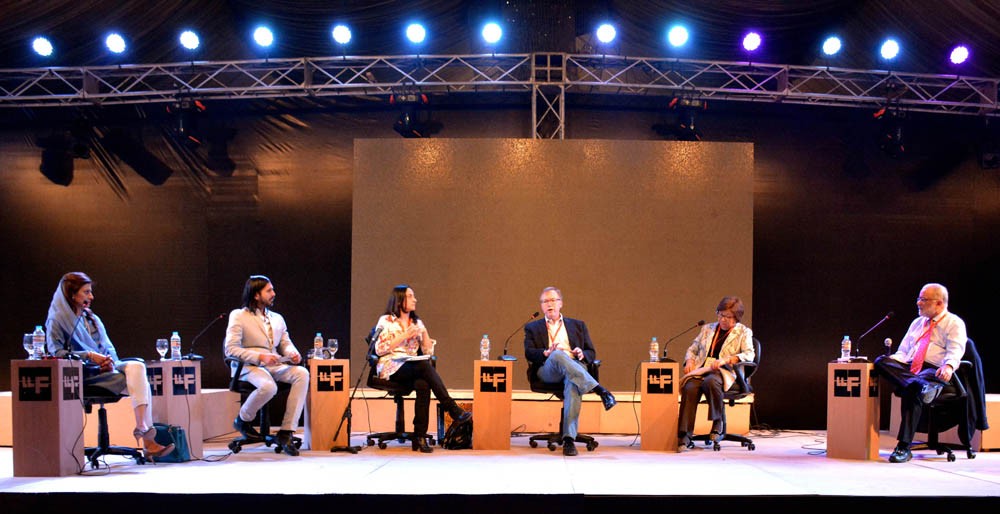
A minimum of ideological posturing and a maximum of excitement, communality, fantasy and fun

Why is it that literary fairs have become so important to international and local cognoscenti? How do they do their job now, compared to other types of exhibitions, such as theme shows, historical surveys, retrospectives, competitions, industrial fairs, group shows organised by artists’ cooperatives and melas? Are literary fairs telling us more about the state of contemporary literature than the writings of critics, historians, and journalists?
It would seem so, if numbers count. Literary fairs have burgeoned all over the world during the past two decades. In every case the goal is the same: to feature, in a regular ongoing manner, the latest developments in international contemporary writing so as to benefit local authors and audiences. Over the past decade, however, their ubiquity has often been questioned, as has their apparently repetitious, elitist nature.
Some charge that fairs are motivated more by the demands of cultural tourism than their avowed purpose of linking local literary practice and taste to international standards.
Lahore Literary Festival 2016 has survived successfully in its fourth year because it has been adaptive enough to take on tasks that museums and state-run initiatives, with the exception of some temporary undertakings, have tended to defer or eschew -- especially the challenges of the contemporary and what does current literature/art look like from a global perspective?
Yet close observers of the contemporary art scene have noticed an undercurrent of concern about the Fair model over the last few years. Having taken the running from museums, criticism, magazines, educational institutions and from theory itself, can a literary fair continue to bear this weight of responsibility? LLF 2016 took on this burden brilliantly. Even though it bowed to the ‘new realities of the contemporary provincial order’, the spirit extended to the Fair itself in only an intermittent, fitful way.
What would art have been like had conceptualism, feminism, political movements and new photography never happened? In this LLF 2016 was contemporaneous. Not just anachronism, but an imaginary counter-temporality has been characteristic of much current experience and practice. From its inception in 2013, the LLF has quickly built up a deserved reputation as the premier showcase of the contemporary literary trends. The organisers set out to plug local and regional literature into the international art circuit, and to do so, as far as possible, on their own terms.
Read also: A full spectrum of arts at LLF
Above all, this has meant a welcome to art that focuses on the specifics of practice at the peripheries, that is critical of tendencies of the official circuit, and that makes its connections laterally, between the cultures of the ‘Third World’, those with the most direct experience of decolonisation. A political programme then, but one executed with a minimum of ideological posturing and a maximum of excitement, communality, fantasy and fun.
There were tensions all around the LLF 2016. Despite the travails, the organisers soldiered on with their ambitious project. What was their goal? The curators expressed their wish to create a show that would show the world that in Asia, Africa, the Middle East, Latin America and the Caribbean there are material and cultural (read political) conditions different from other regions which condition a type of expression, a narrative, and that in these regions the diverse cultural expressions establish a type of relationship with the public that is considered part of life, without mediation of any institution or specific technological requirements.
But was this wishful, unrealistic thinking? Yes and no. In the event, certain refusals and acceptances shaped the LLF 2016; with big-name Asian and western artistes participating.
A high point was the Indian female actor, Sharmila Tagore and her compatriot B N Goswamy -- the living authority on Pahari miniature, a presence that was felt throughout. A relatively smaller selection of literary figures -- but each generously represented -- convened a succinct summary of diverse strands of literary practice in the opening years of the twenty first century. The LLF 2016 indeed revealed a sampling of significant writers from across the globe, including Ahdaf Soueif, Reza Deghati, Madhur Jaffrey, Marion Molteno, C M Naim, Sudeep Sen, Tania James, and many others.
The LLF 2016 was not unlike the ceramic work of Scheherezade Alam in its pursuit of certain ‘classicism’ within a panoply of stratified and differentiated artistic agendas drawn from around the world. However, after accomplishing such a summarising and consolidating fair (in spite of all the eleventh hour glitches), the LLF 2017 will be sufficiently armed once again to focus on the emerging, the untried and the more pointedly experimental work within the evolving topography of contemporary literature.